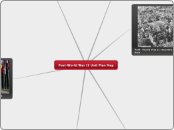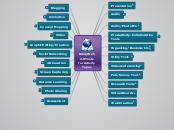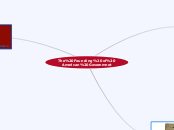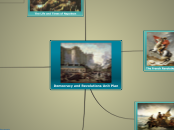Post-World War II Unit Plan Map
The Fall of Communism in the Soviet Union
The students will describe the events that led to the fall of communism in the Soviet Union.
The World and its Alliances
The students will analyze and discuss the formation of the UN, Warsaw Pact, SEATO, NATO and the Organizations of American States. The students will also discuss and deliberate upon the functions and responsibilites of these entities.
Acceptable Evidence: The students will fill out their exit journals, responding to the questions that the teacher has posed to them. Once the teacher has read them she can use the information to help tweak her lesson, and as a way to see if there were concepts that the students did not understand and what may need to be retaught.
Acceptable Evidence: During the presentation the teacher will roam around the classroom presenting theinformation but also watching the students fill out their guided notes, if she see’s anything wrong the teacher can use this time to immediately correct the students. Also while the students are in groups working through the statements hey were given the teacher will roam around the classroom listening to the discussions, if groups are off or siting incorrect evidence the teacher can guide the groups to the correct evidence.
Lesson Activities: After the class discussion the teacher will ask the students to take out their class journals and write 3 things that they learned, also the teacher will ask the students to reflect on the four corners activity, did any of their opinions about the statements change, if so why?, if not also why?
Lesson Activities: At the beginning of the lesson the teacher will give a short presentation on the formation of the United Nations, Warsaw Pact, NATO, SEATO and OAS; as well as their functions throughout the world. During this presentation the teacher will define the vocabulary terms listed above. The students will be using their guided notes to follow along with the presentation. The main point of this lesson is a class discussion, they will be discussing and deliberating the functions and responsibilities of these entities. Strategy: Four Corners
Lesson Activities: The teacher will begin the lesson by showing the students 2 political cartoons, one about the UN and one about NATO. The teacher will then ask the students to analyze the cartoons,
Acceptable Evidence: The lesson introduction, analyzing political cartoons allows the teacher to assess the students’ prior knowledge about the UN and the Warsaw Pact, this also allows the teacher to manipulate any incorrect ideas as well as cement the correct ones.
Communist Regime in China
Students will analyze and evaluate the rise of the Communist Regime in China.
Nationalism in the Middle East
The students will analyze, describe and illustrate the forces of nationalism in the Middle East, the effect of the Holocaust and the significance of the creation of Israel, as well as the significance of these changes
Acceptable Evidence: The students will finish filling out their anticipation guide and graphic organizers, the answers the students will provide will serve to inform the teacher as to what concepts the students understood and which ones that the teacher may need to revisit.
Acceptable Evidence: While the students are completing their graphic organizers, the teacher will roam around the room checking for understanding, as well as guiding students who may not be grasping the content that is required of them.
Lesson Activities: After the students finish their graphic organizers the teacher will ask them to revisit their anticipation guide and answer the question, “Now that we have had a discussion on these topics would you change your answers? If so explain? If not explain why not?”
Lesson Activities: While reading the students will fill out the graphic organizer that is provided for them. The students will be asked to bullet point the rise of nationalism in Iran and Egypt. Then the students will be asked to create a time line for the creation of Israel, and the students will finish by briefly describing how these influences the world today. The students will also have a vocab list at the bottom of their graphic organizer and they will be asked to draw a picture for each word
Lesson Activities: The teacher will begin the lesson by having the students fill out an anticipation guide, the anticipation guide will ask the students to give their own definition of the word nationalism and how they think nationalism will affect the post-World War II world.
Acceptable Evidence: the lesson begins with an anticipation guide, the purpose of the guide is to elicit the student’s prior knowledge on the topic of nationalism. The discussion that follows also is a way of gauging the student’s prior knowledge as well as a way to help manipulate their current schema, if it is incorrect.
Post- World War II recovery in Europe and Asia
The students will consider and discuss the importance of the Truman Doctrine and the Marshall Plan as well as compare and contrast the post-World War II recovery of Germany and Japan.
Acceptable Evidence: The exit journals that the students will write will serve as a summative assessment. The teacher will read them after the lesson, this will help the teacher gather the amount of the lesson the students understood as well as inform the teacher of what concepts might need to be covered again depending on the answers given.
Acceptable Evidence: Throughout the lesson there are multiple questions that are posed to the students, while the students are discussing these critical thinking questions the teacher will walk around, this will give the teacher an idea of what the students are understanding.
Lesson Activities: At the end of the lesson the teacher will ask the students to write in their exit journals. The students will write down five concepts that they learned and then three things that they want to learn more about or our still confused about.
Lession Activities: Throughout the lecture the students will be filling out and following along with the guided notes that have been provided for them.
Lesson Activities: The teacher will deliver a lecture regarding the post-World War II recovery, focusing on the Truman Doctrine, Marshall Plan, Division of Germany and Recovery in Japan.
Actceptable Evidence: The students will make predictions about the world after World War II, and participate in a class discussion.
U.S. and Soviet Tensions
Students will give examples and describe of "Cold War" interactions between the U.S. and Soviet Union.









